This easy homemade ciabatta bread recipe yields a very light and airy texture with a crisp, golden exterior. You don't need to be a professional artisan bread maker to achieve such amazing rustic Italian loaf.
Since you're here, I bet you love making artisan bread at home. Besides this traditional ciabatta bread, I also have successfully accomplished this yeasted artisan cheddar cheese bread. Just another rustic loaf filled with oozy, delicious pocket melted cheese.
On the other hand, if you want to try rich and sweet bread, this caramel monkey bread or this condensed milk bread will amaze you. Ever tried flavoring bread such as this twisted cinnamon raisin bread? If not, it's also worth a shot. They are the opposite of rustic breads and surely will satisfy even the pickiest artisan-bread-eater on the planet.
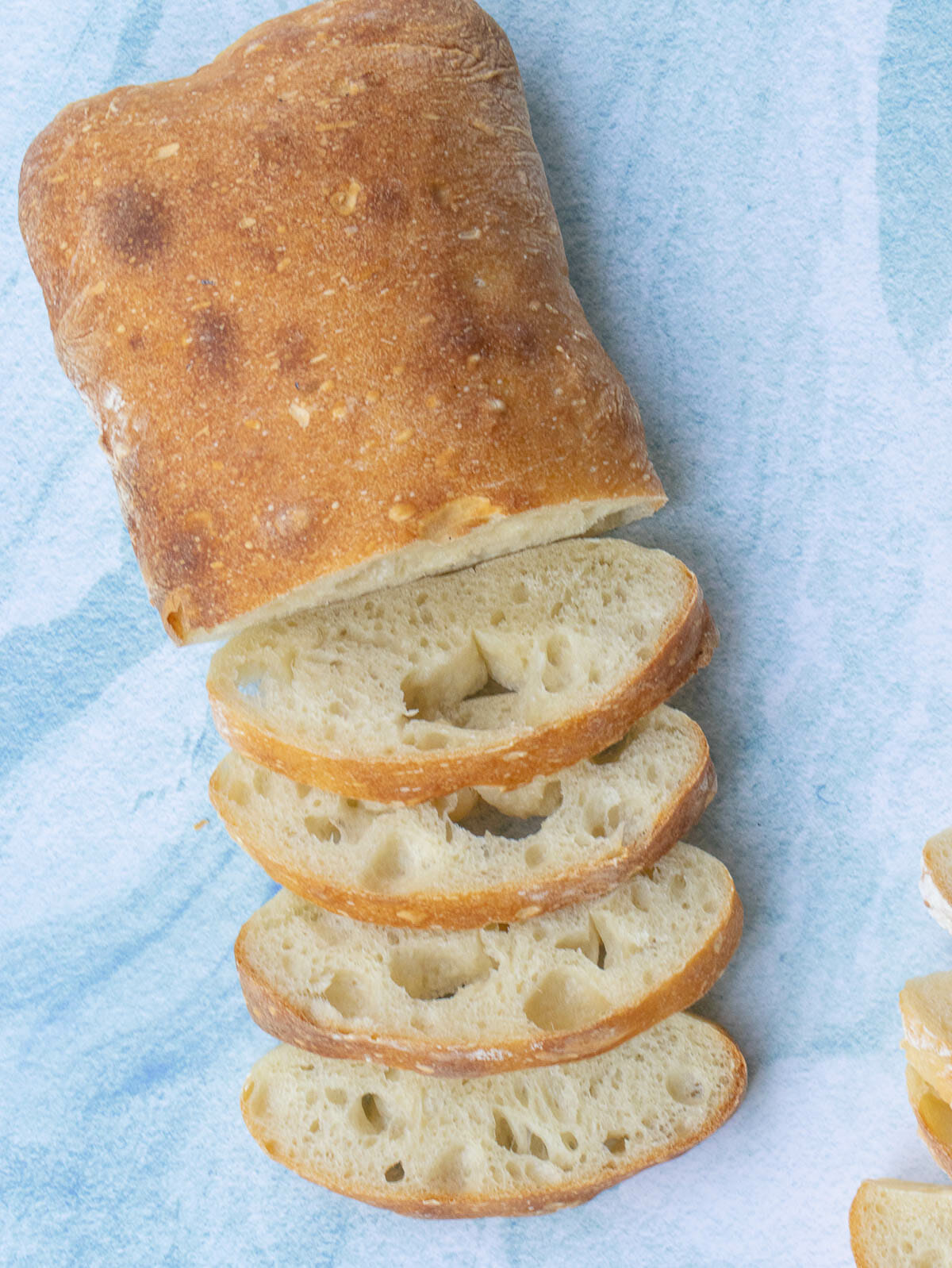
What is ciabatta bread?
A traditional ciabatta bread is made of an extremely wet dough which helps giving the dough its signature holes and a rustic, golden, crisp exterior. Also, ciabatta does not require any scoring like other artisan rustic breads.
In order to achieve such light and airy ciabatta bread, I opted for all purpose flour instead of bread flour. Since AP flour has less protein content compared to the bread flour, the development of gluten will also be limited during the mixing process.
Also, the bread dough is fermented in two stages. The first stage happens in a thick yeasted batter called sponge. The second stage happens in a bread dough with remaining ingredients added. This two-time-fermentation method gives the ciabatta different flavor and airy, lighter texture than breads made with one-time-fermentation only.
Useful baking tips
- Ciabatta bread is made of a very sticky and wet dough so you need to work as quickly and gently as possible to prevent the bread structure to collapse. Which means you should read the whole recipe at least 1 time prior to starting making ciabatta.
- The bread starter, sponge, takes anywhere from 4 to 6 hours depending on the amount of yeast, type of yeast, and proofing temperature. So it is important to include sponge proofing time in your baking schedule.
- Since sponge can sit at room temperature for maximum 24 hours, it is easier to make sponge a night before your bread day.
- The bread sponge should be mixed in a plastic or other non-reactive mixing container as it ferments. A rubber spatula is also a perfect choice when it comes to kneading this sticky dough.
- The light and airy homemade ciabatta bread recipe calls for room temperature water and proofing at normal room temperature (75F). But you can always use warm water and proof the dough in a warm environment (75F-95F) to speed up the fermentation process.
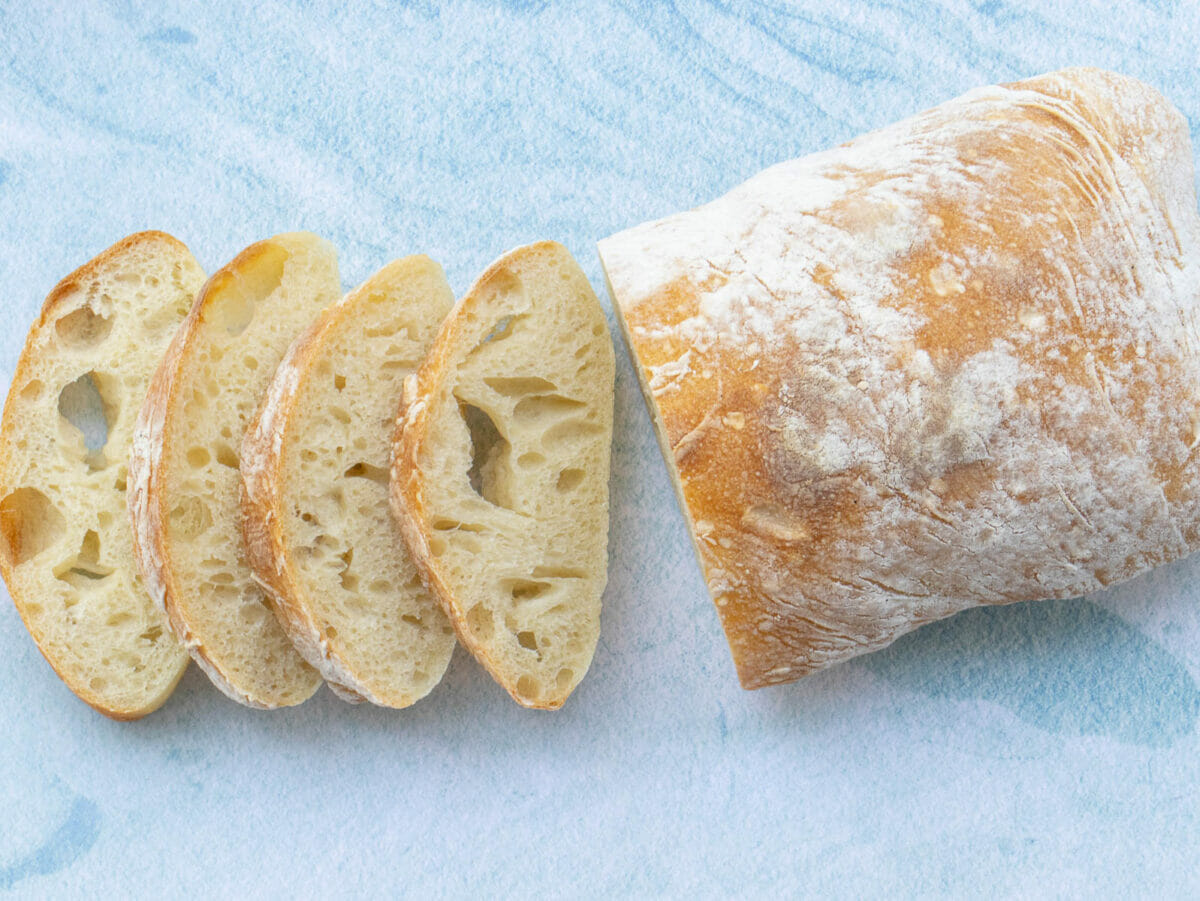
How to make light and airy ciabatta bread
This homemade ciabatta bread is a rustic Italian load that starts with a sponge. A sponge requires a sufficient amount of time to ferment, about 4 to 6 hours at room temperature.
Also keep in mind that this ciabatta dough is wet and very sticky so it is best not to mix this bread dough by hand. A stand mixer, a large mixing bowl, and a spatula will do the job perfectly.
Make sponge
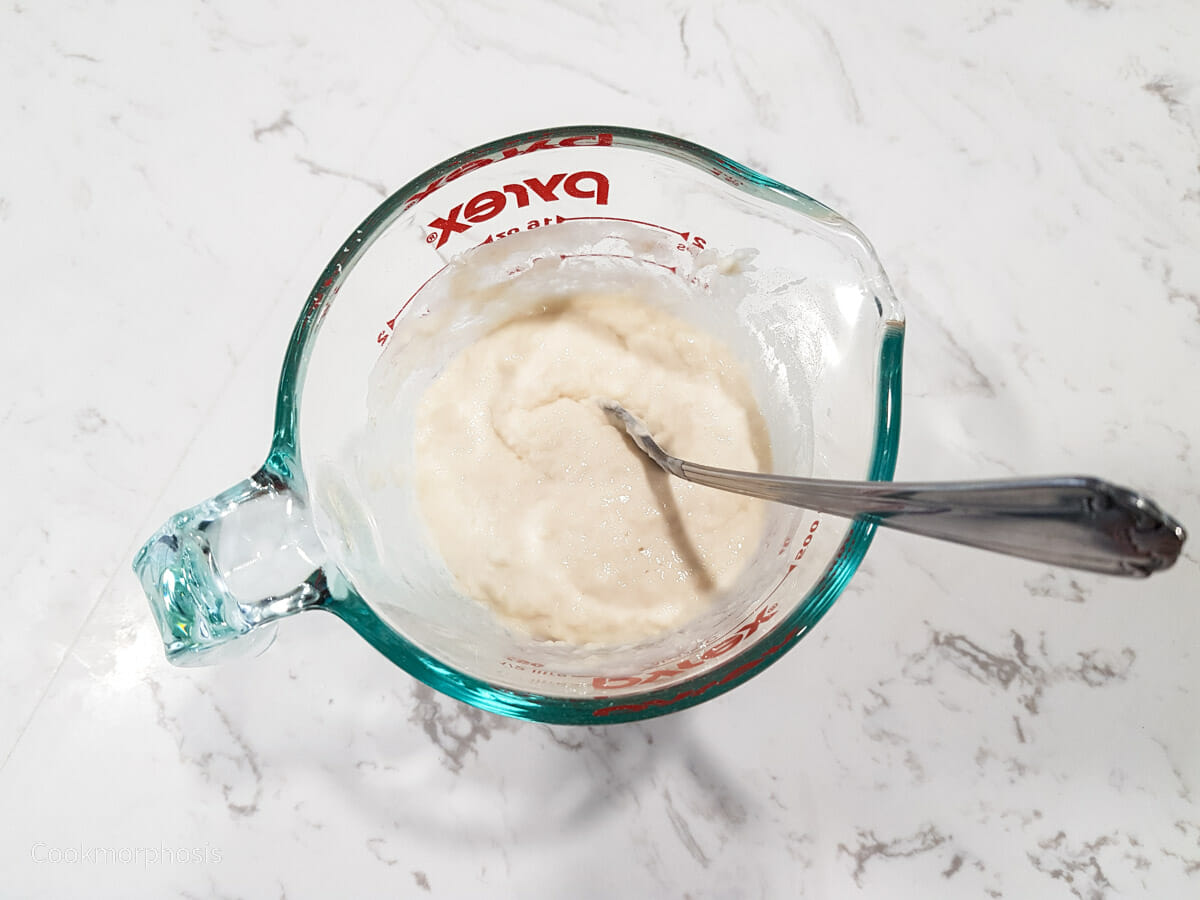
Make the sponge: In a medium size plastic or non-reactive container, stir all the ingredients together. Cover the bowl tightly with plastic wrap and let it ferment at room temperature.

Ferment the sponge: The sponge is ready when it has doubled in size, approximately 4 to 6 hours. Sponge can sit at room temperature for up to 24 hours.
Mix dough
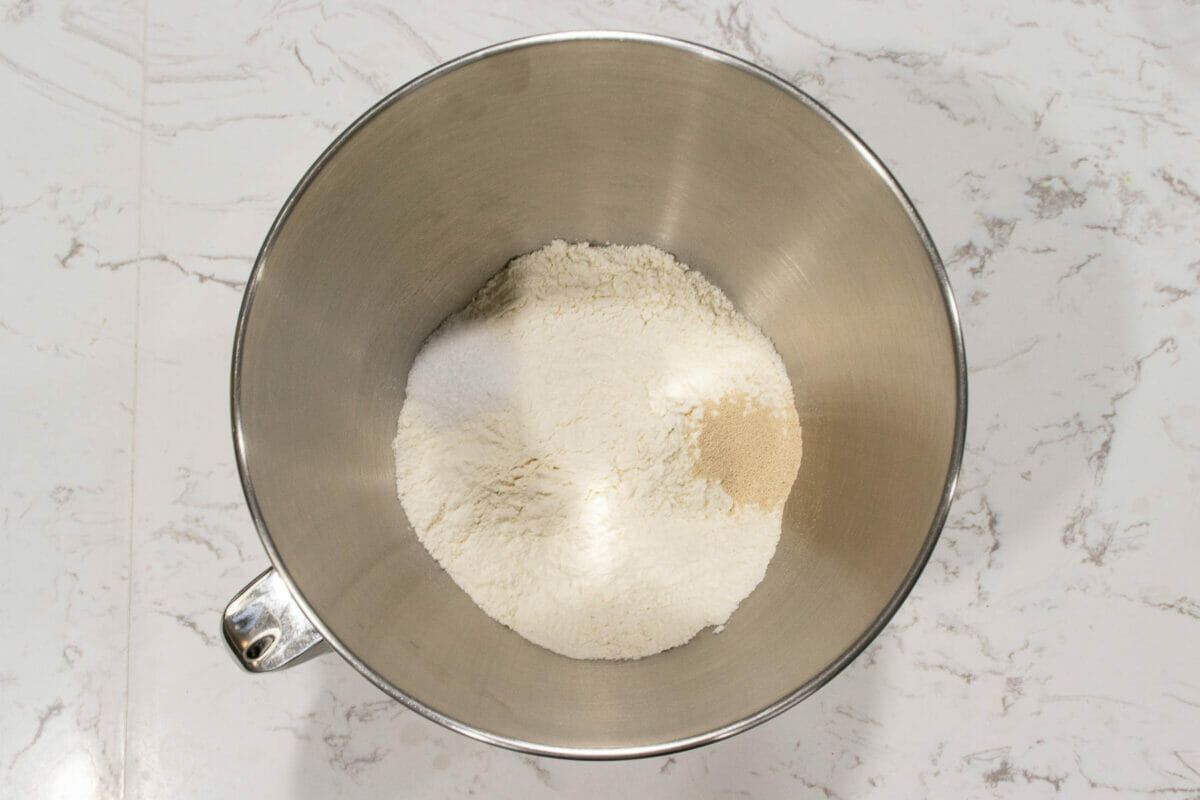
Make bread dough: In a mixing bowl of a stand mixer, combine all dry ingredients.
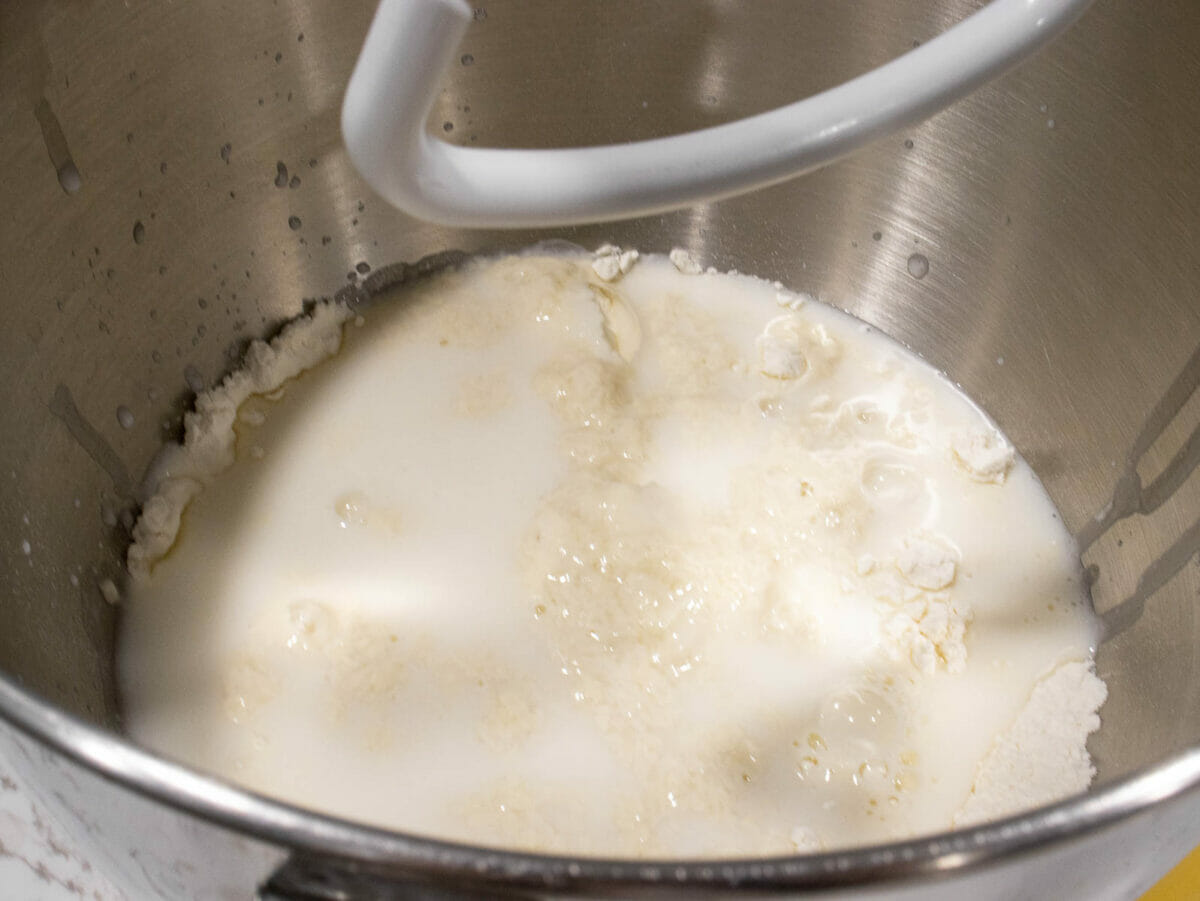
Start mixing process: Add water into the sponge. Use a rubber spatula, stir the mixture until well combined. Slowly add sponge mixture to flour mixture.
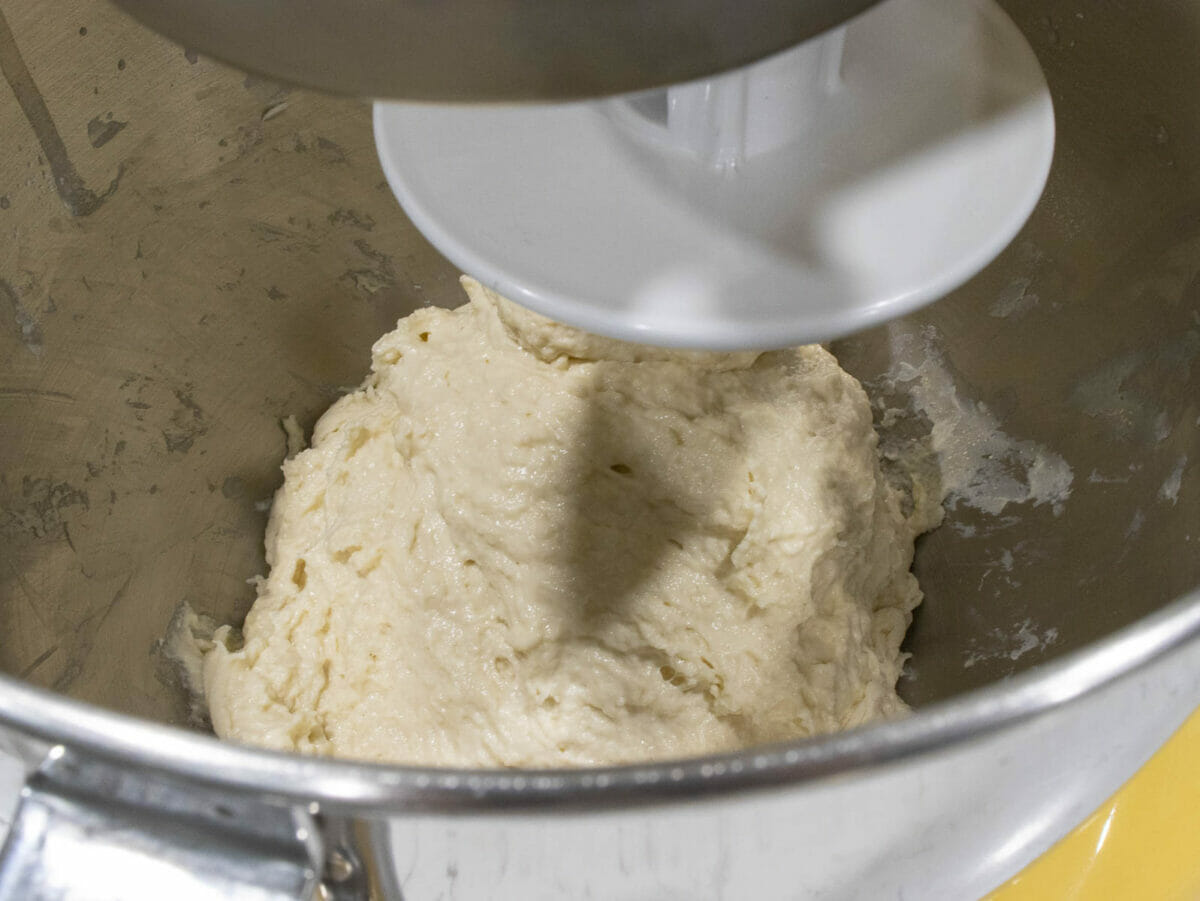
Mix the dough: On medium-low speed, start mixing everything together, using a dough hook, until a cohesive dough formed, approximately 3 minutes. You can stop the mixer and scrape down sides of the bowl as needed.
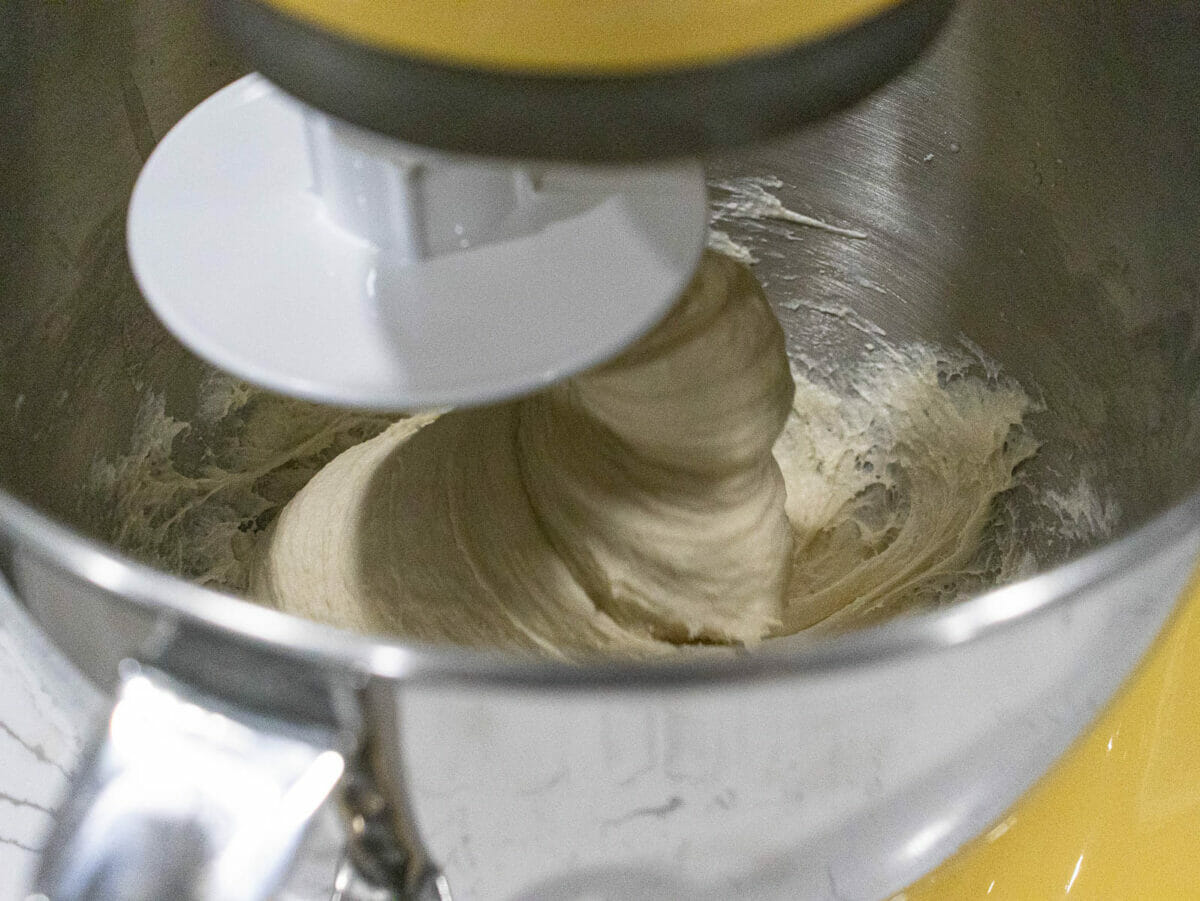
Continue mixing in stand mixer: Increase the speed to medium setting and continue to knead until the dough is completely smooth, becomes shiny, pulls away from the sides and there is absolutely no dry ingredients left. The dough is supposed to be very sticky. This process takes about 10-12 minutes.
Proof dough
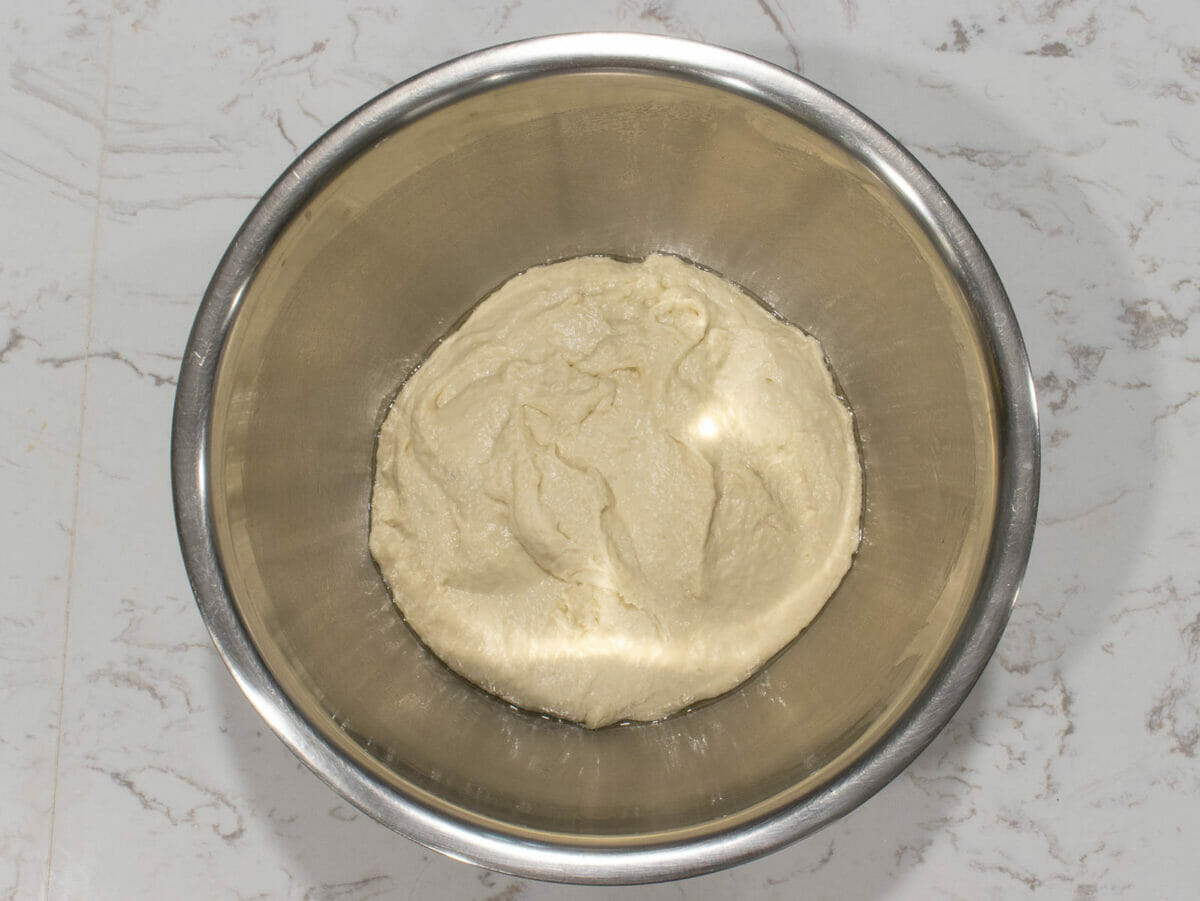
First proof of ciabatta bread dough: Transfer the dough to a lightly greased large mixing bowl (you can grease with flour or oil). Cover the dough tightly with plastic wrap and let it rest until double in size, approximately an hour.
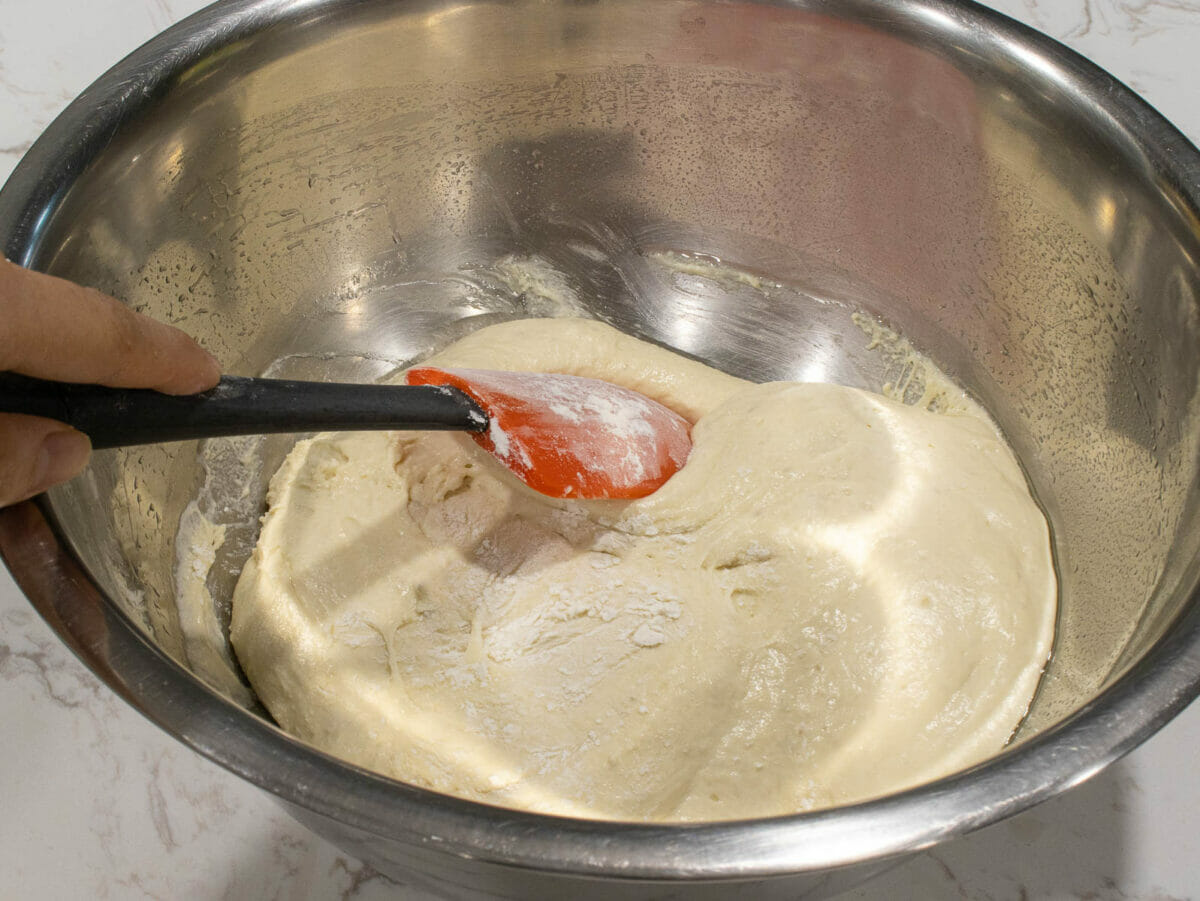
Fold bread dough: Grease a rubber spatula generously with flour. Then use it to fold the dough (after it was done with first proof) by gently lifting and folding the edge toward the middle.
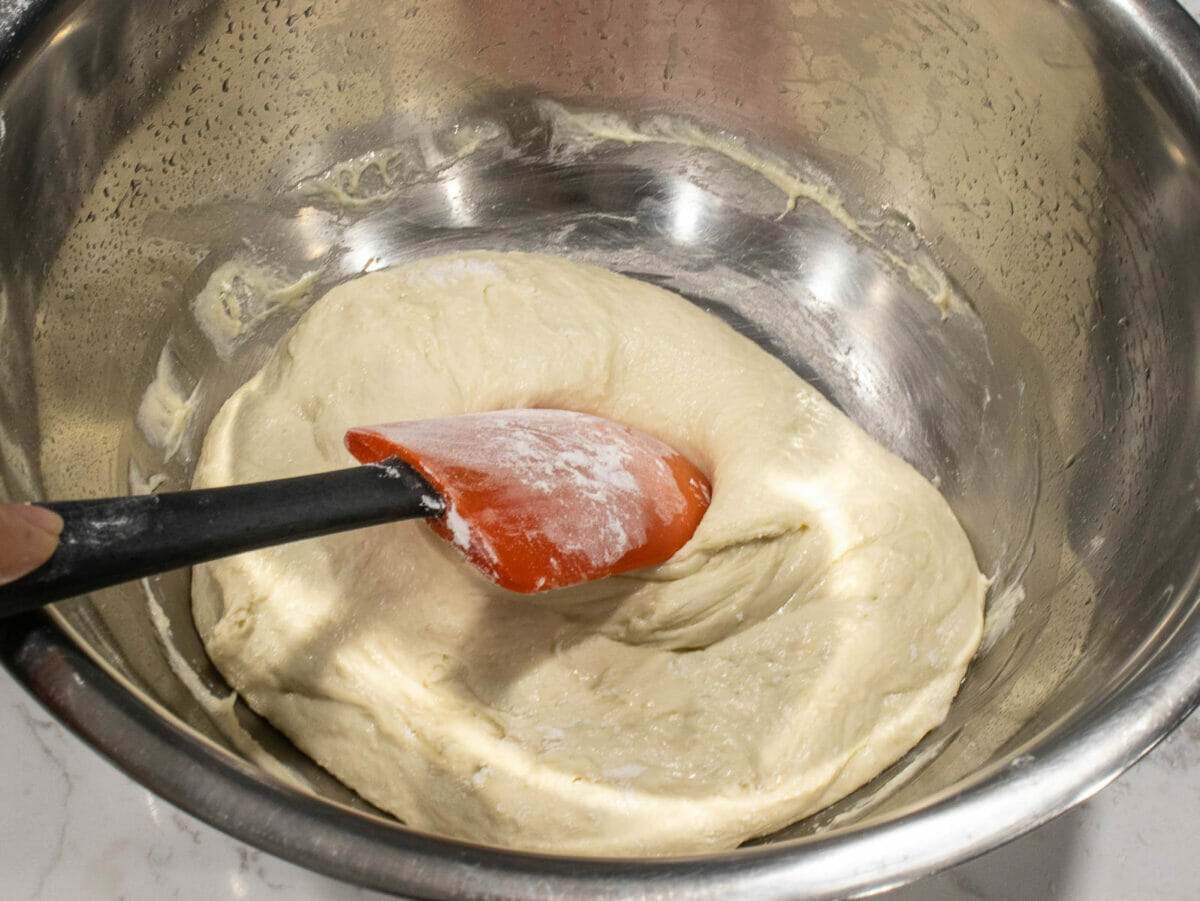
Continue to fold: Turn the bowl 45 degrees and fold the edge toward the middle again. Repeat the turning and folding process 7 more times.
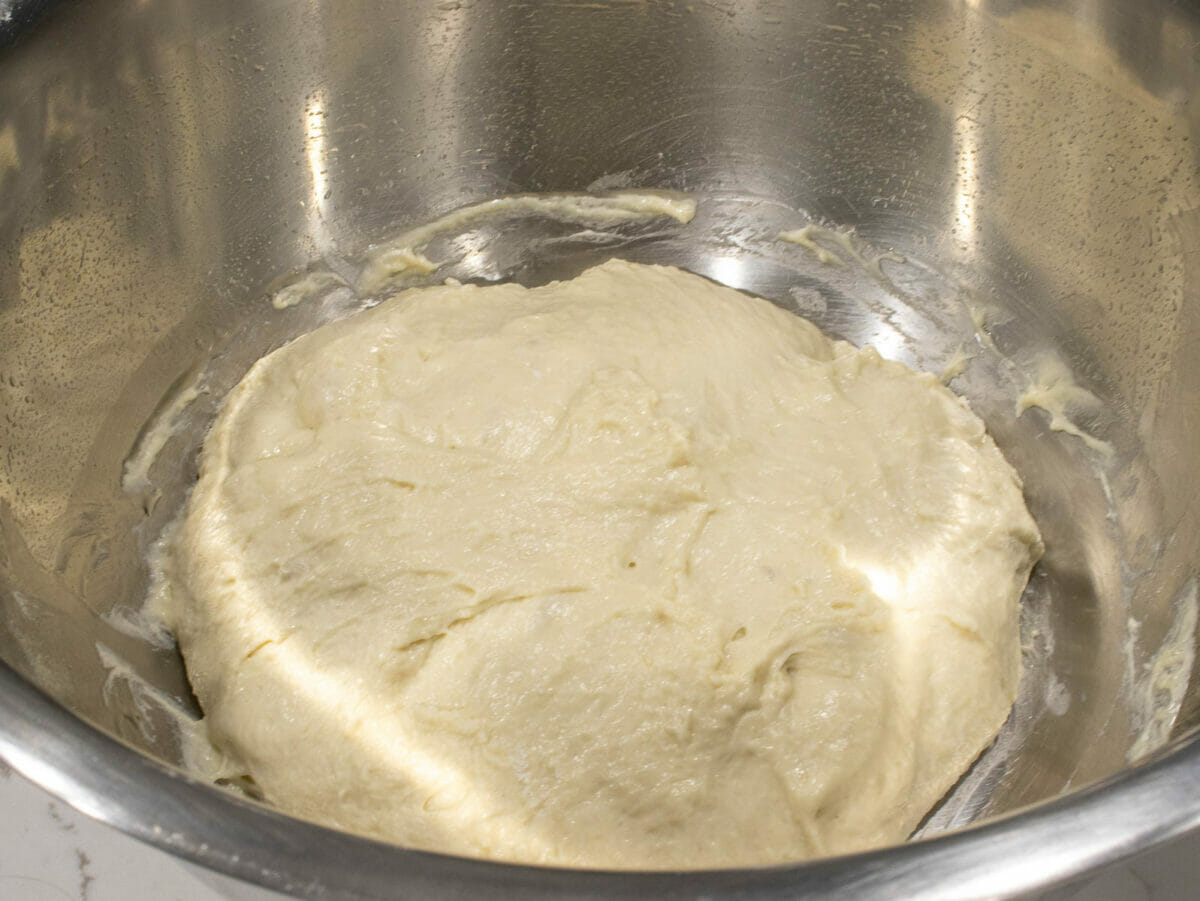
Second proof: Cover the bowl tightly with plastic wrap and let it ferment for another 30 minutes.

Third proof: Repeat the folding steps then cover the bowl again with plastic wrap and let it rise until nearly doubled in size, approximately 1 to 1.5 hours.
Hand-fold dough
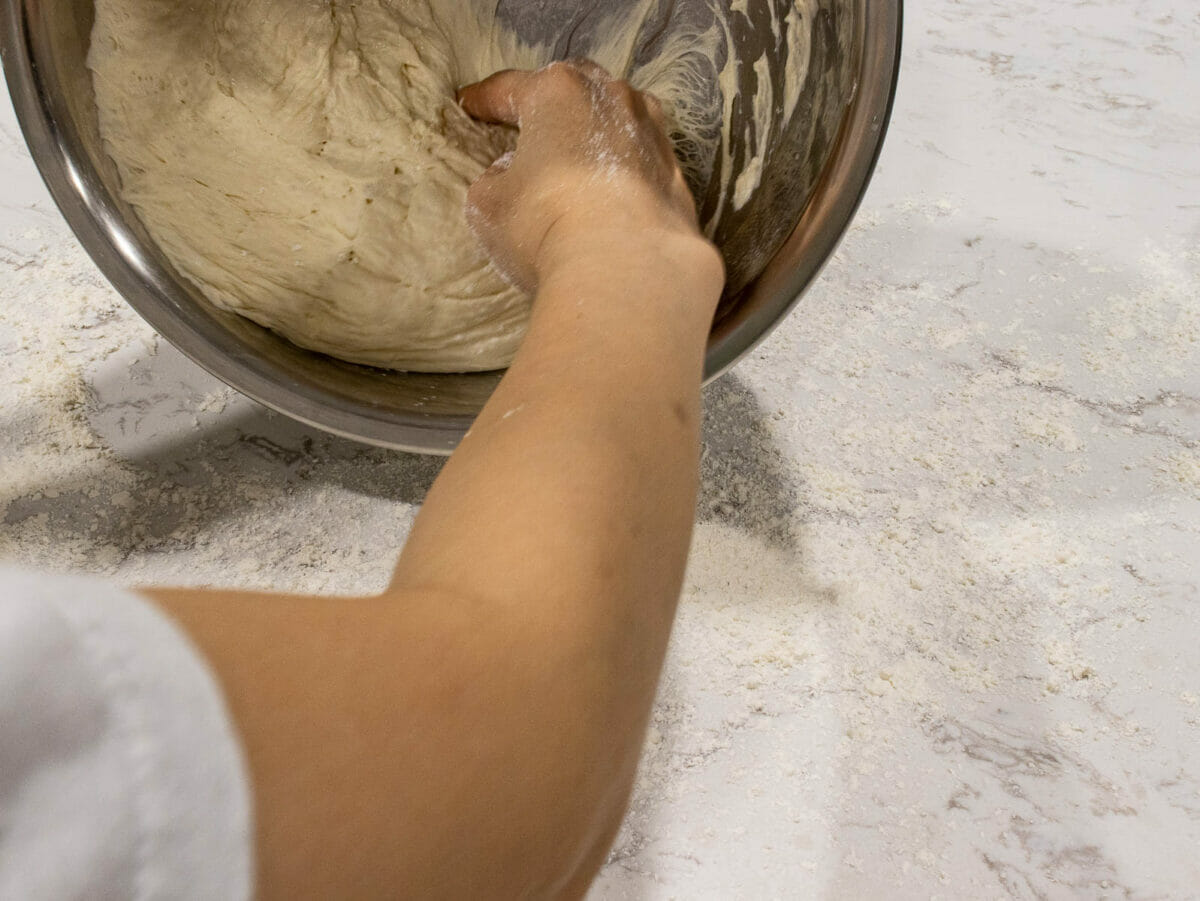
Transfer bread dough to working surface: Line a rimmed baking pan with parchment paper. Set aside for later use. Transfer the dough to a heavily floured surface. Remember to generously flour your hands too.
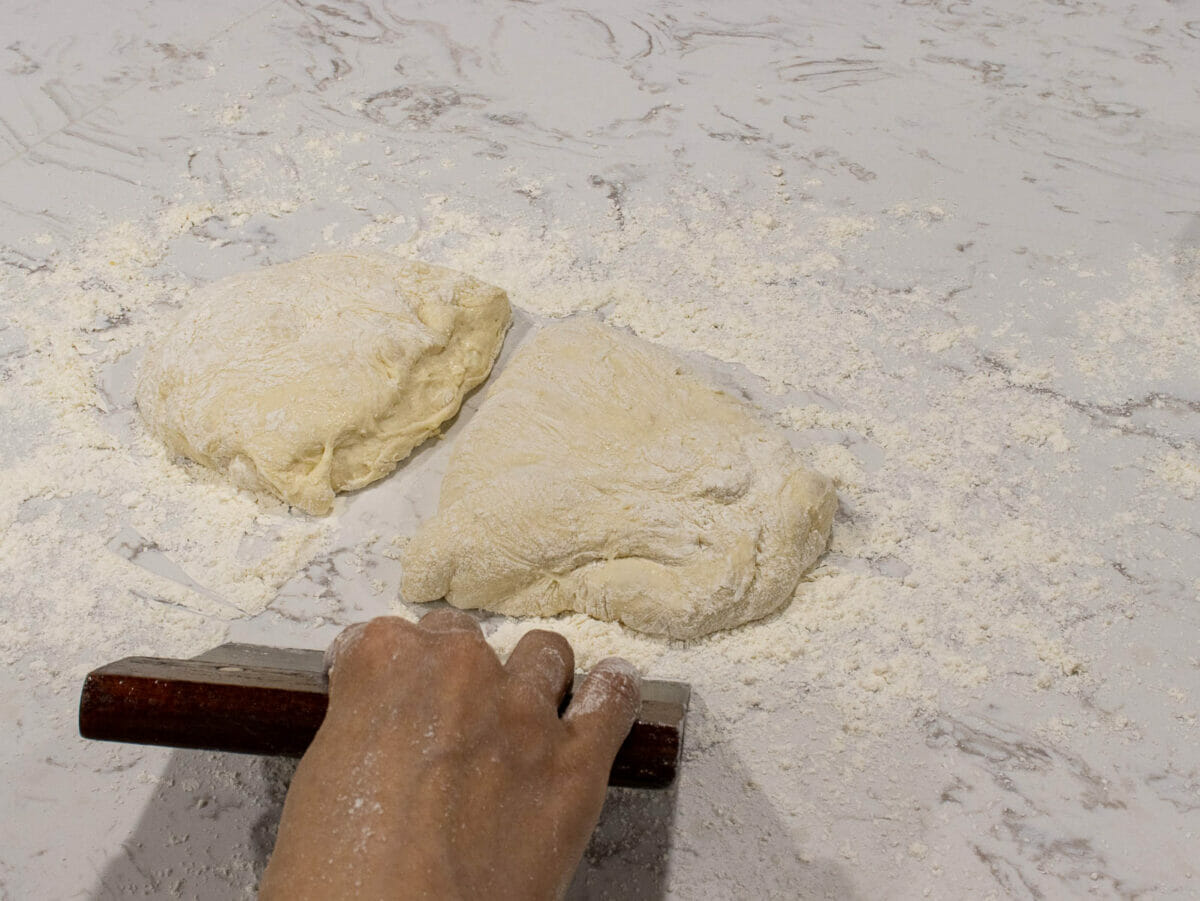
Divide dough in half: Dust the top of the dough with flour and use a scraper to cut the dough in half.
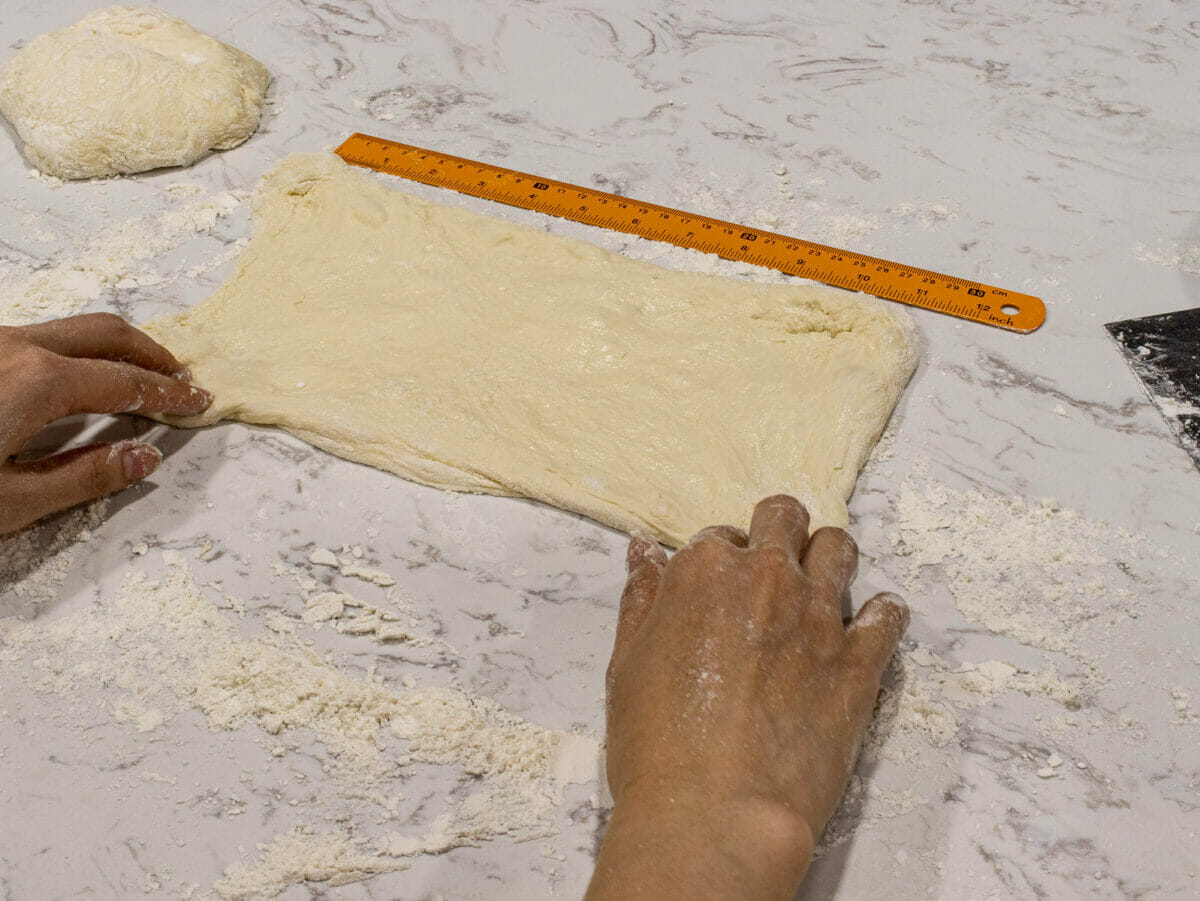
Stretch the dough: Work with 1 piece at a time. Using your hands, press and stretch the dough into a 7x11 inch rectangle, about 1 inch thick.
Shape dough
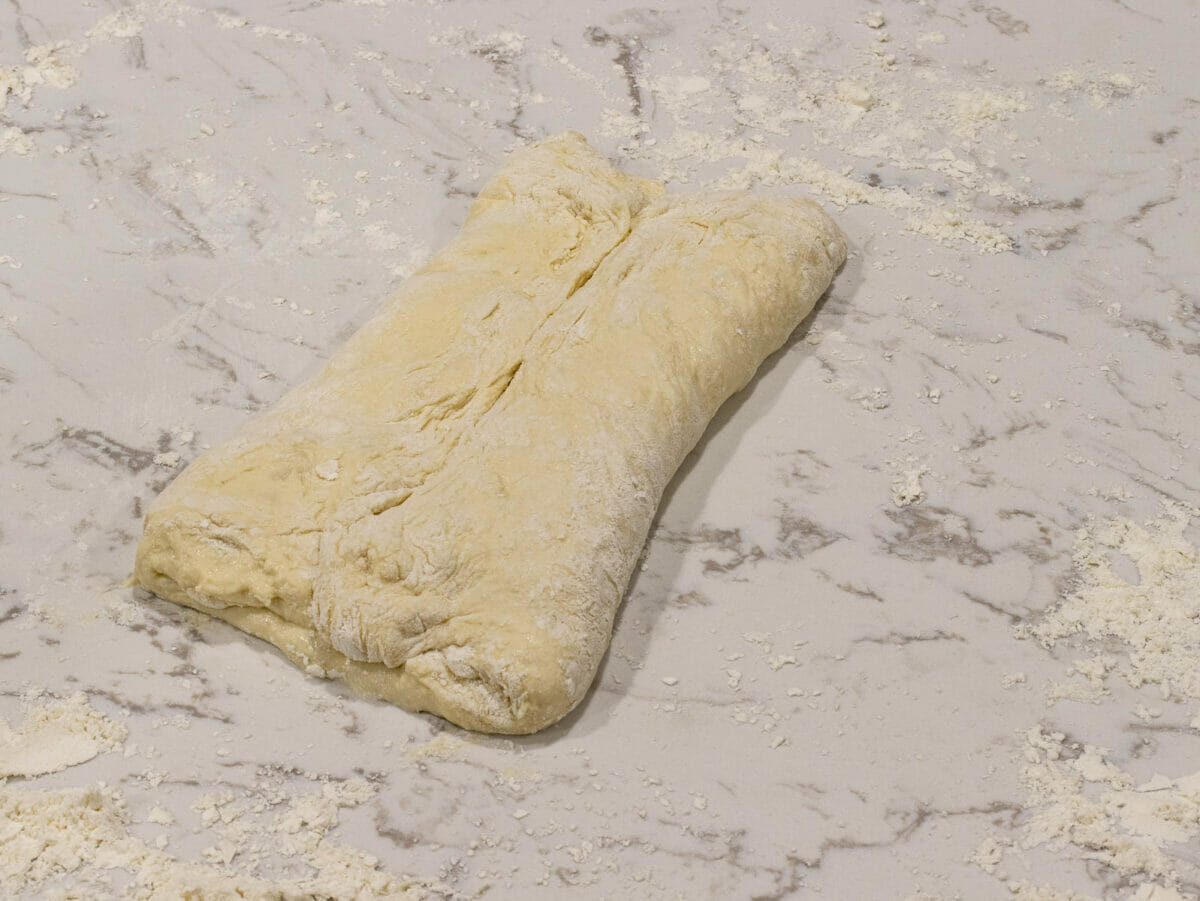
Shape the dough: Stretch and fold top and bottom of the toward the middle to form a 4x8 inch rectangle. Pinch the seam together. Repeat these steps with the second piece.
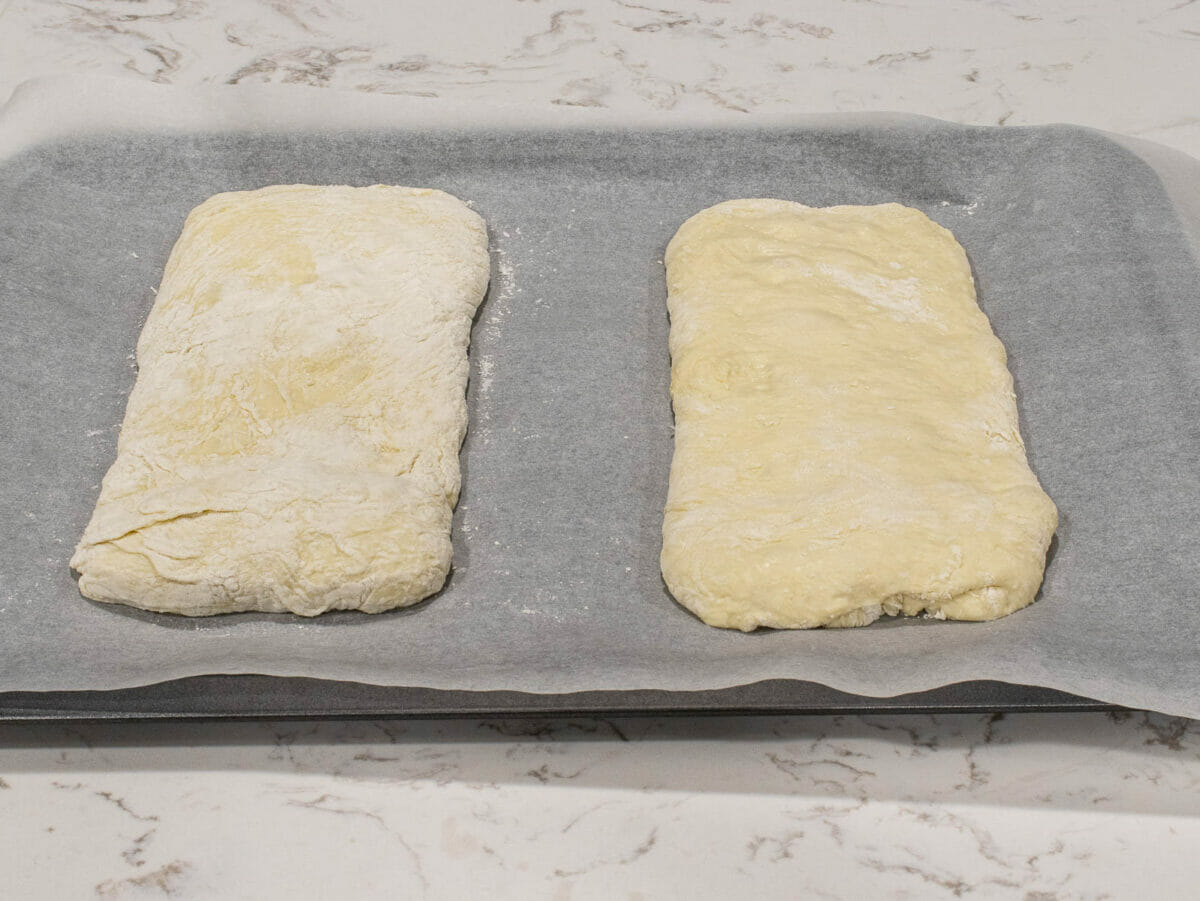
Fourth proof: Carefully move ciabatta bread dough on the baking pan, seam sides down. Cover them loosely with plastic wrap and let them proof until the dough springs back slowly, and there are small bubbles appeared on the top of the loaves, approximately 45 to 1 hour.
Bake bread
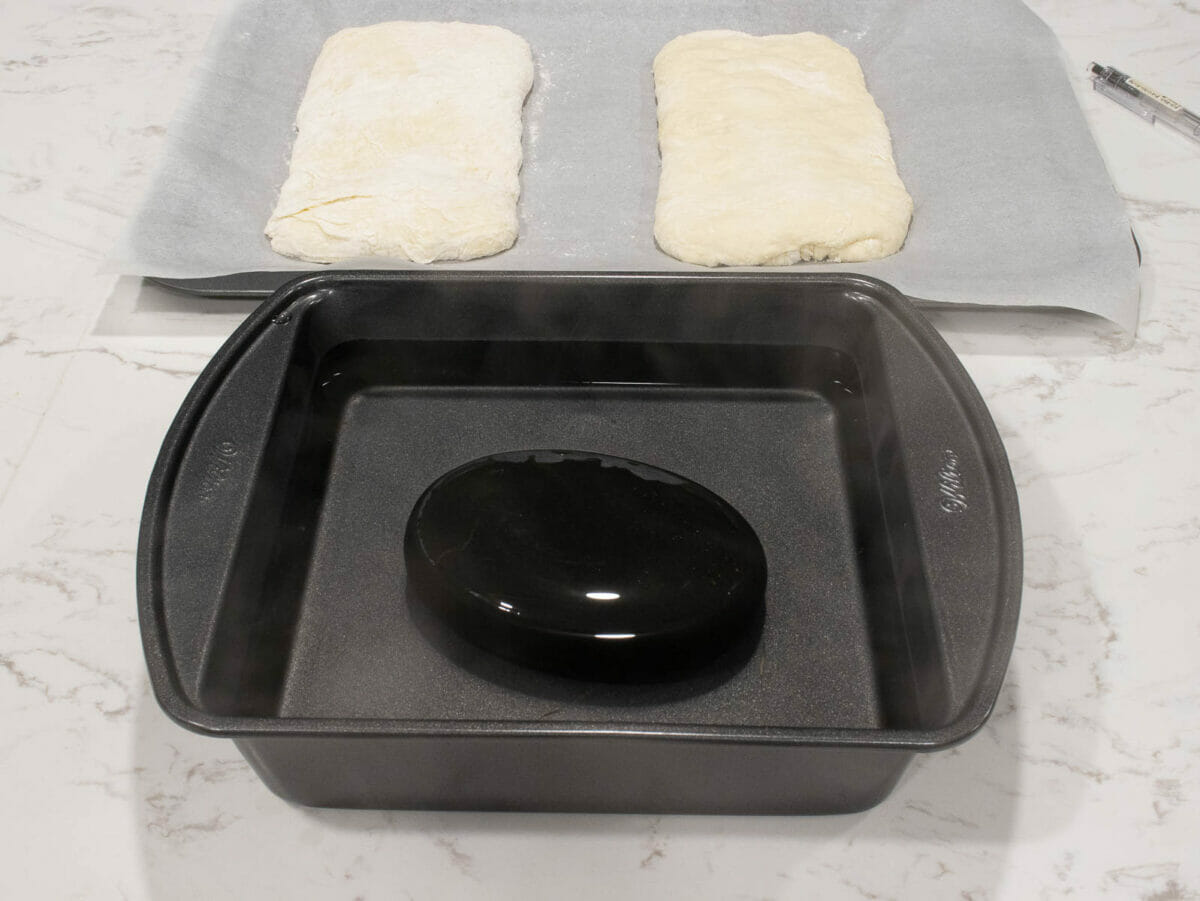
Prepare oven: Pre-steam the oven at 450F with a pan of hot water put on the lowest rack. You can use baking or massage stone to elaborate the steaming process.
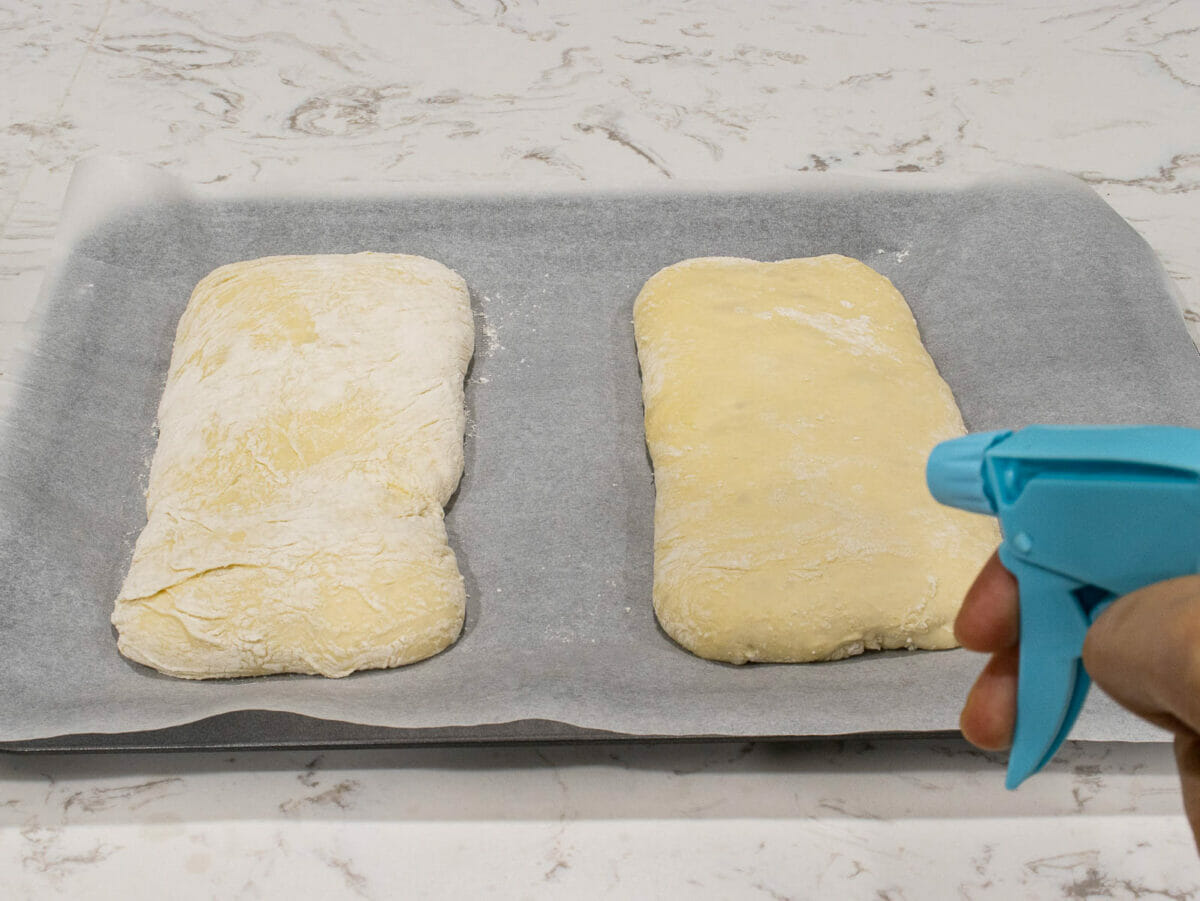
Mist the bread dough: When the dough is ready, quickly mist the loaves with a little bit of water. Then immediately put into the oven and bake for 20-23 minutes.
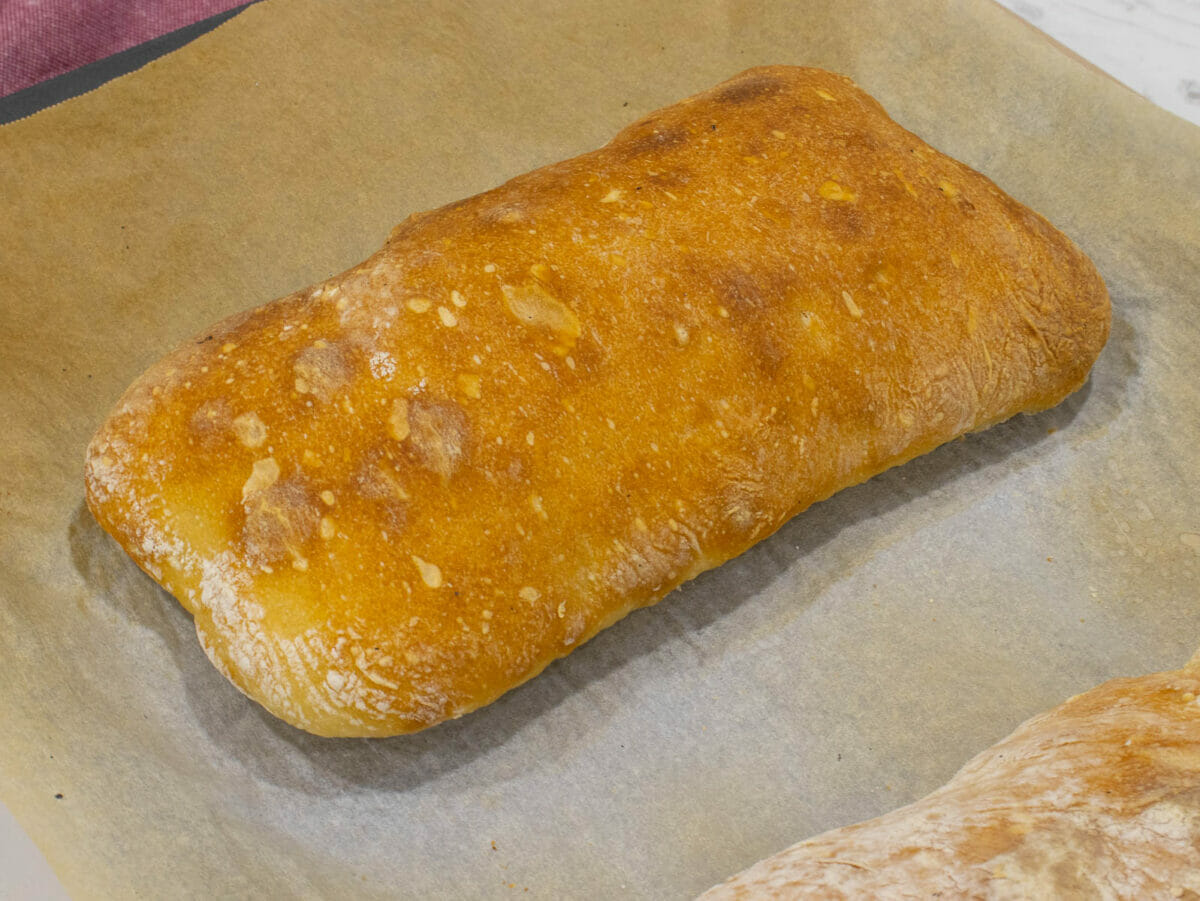
Check for doneness: 10 minutes after the loaves are baked in the oven, quickly open the oven door and mist the dough again. 5 minutes before the baking time is over, carefully open the oven door, use a towel to keep it open for a few inches to vent any excess steaming. Ciabatta bread is done when the crust is golden brown and sounds hollow when lightly tap on the top. Cool the bread completely on racks before serving, approximately 1 to 1.5 hours.
FAQs
This ciabatta bread dough has high hydration level which gives the load a dramatic chewy, open crumb and airy texture. So to work with it easily, you only need few folding steps to shape the bread (see how-to steps for more information). In order to do so, you need to generously flour your hand as well as a working counter. Or you can use a big parchment paper to avoid extra contact with the counter if prefer.
Yeasted breads in general should be cooled down at room temperature on a rack. It'll take somewhere from 1 to 3 hours to completely cool down, depends on the bread side. For these ciabattas, it'll take maximum 1.5 hours.
Once cool completely, ciabatta can be wrapped tightly in plastic wrap and store at room temperature for maximum 2 days. Or you can freeze it for up to 2 weeks. Do not refrigerate any kind of bread.
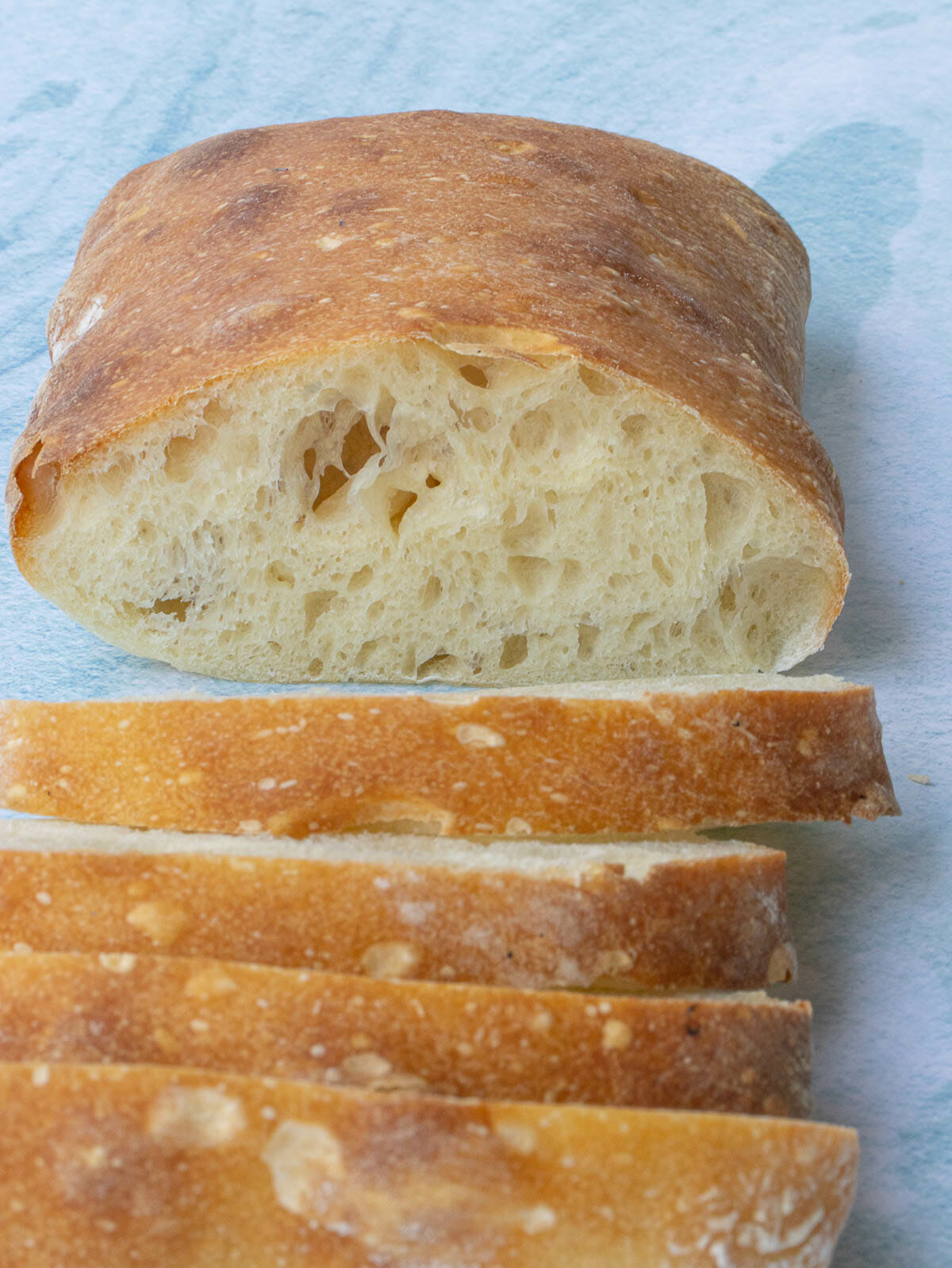
Did you make this recipe? If so please leave a rating and let me know how it went in the comment section. Also, don't forget to tag me #cookmorphosis @cookmorphosis on social media.
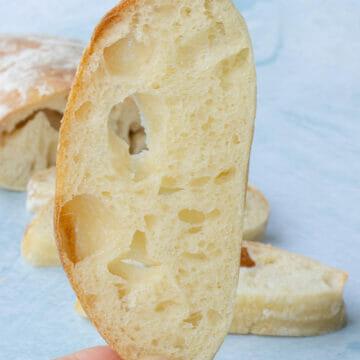
Light and airy homemade ciabatta bread
Ingredients
For the sponge
- ⅔ c AP flour
- ⅓ c water room temperature
- ¼ tsp instant yeast
For bread dough
- 2 ⅓ c AP flour
- 1 tsp salt
- ½ tsp instant yeast
- 1 c water room temperature
Instructions
Make the sponge
- In a medium size plastic or non-reactive container, stir all the ingredients together. Cover the bowl tightly with plastic wrap and let it ferment at room temperature.⅔ c AP flour, ⅓ c water, ¼ tsp instant yeast
- The sponge is ready when it has doubled in size, approximately 4 to 6 hours. Sponge can sit at room temperature for up to 24 hours.
Make bread dough
- In a mixing bowl of a stand mixer, combine all dry ingredients.2 ⅓ c AP flour, 1 tsp salt, ½ tsp instant yeast
- Add water into sponge. Use a wooden spoon or spatula, stir the mixture until well combined. Slowly add sponge mixture to flour mixture.1 c water
- On medium-low speed, start mixing everything together, using a dough hook, until a cohesive dough formed, approximately 3 minutes. You can stop the mixer and scrape down sides of the bowl as needed.
- Increase the speed to medium setting and continue to knead until the dough is completely smooth, becomes shiny, pulls away from the sides and there is absolutely no dry ingredients left. The dough is supposed to be very sticky. This process takes about 10-12 minutes.
First proof
- Transfer the dough to a lightly greased large mixing bowl (you can grease with flour or oil). Cover the dough tightly with plastic wrap and let it rest until double in size, approximately an hour.
Second proof
- Grease a rubber spatula generously with flour. Then use it to fold the dough (after it was done with first proof) by gently lifting and folding the edge toward the middle.
- Turn the bowl 45 degrees and fold the edge toward the middle again. Repeat the turning and folding process 7 more times.
- Cover the bowl tightly with plastic wrap and let it ferment for another 30 minutes.
Third proof
- Repeat the folding steps above. Then cover the bowl again with plastic wrap and let it rise until nearly doubled in size, approximately 1 to 1.5 hours.
Shape bread dough
- Line a rimmed baking pan with parchment paper. Set aside for later use.
- Transfer the dough to a heavily floured surface. Remember to generously flour your hands too.
- Dust the top of the dough with flour and use a scraper to cut the dough in half.
- Work with 1 piece at a time. Using your hands, press and stretch the dough into a 7x11 inch rectangle, about 1 inch thick.
- Stretch and fold top and bottom of the toward the middle to form a 4x8 inch rectangle. Pinch the seam together.
- Repeat these steps with the second piece.
Fourth proof
- Carefully move ciabatta bread dough on the baking pan, seam sides down. Cover them loosely with plastic wrap and let them proof until the dough springs back slowly, and there are small bubbles appeared on the top of the loaves, approximately 45 to 1 hour.
Bake ciabatta
- Pre-steam the oven at 450F with a pan of hot water put on the lowest rack. You can use baking or massage stone to elaborate the steaming process.
- When the dough is ready, quickly mist the loaves with a little bit of water. Then immediately put into the oven (middle rack) and bake for 20-23 minutes.
- 10 minutes after the loaves are baked in the oven, quickly open the oven door and mist the dough again. 5 minutes before the baking time is over, carefully open the oven door, use a towel to keep it open for a few inches to vent any excess steaming.
- Ciabatta bread is done when the crust is golden brown and sounds hollow when lightly tap on the top. Cool the bread completely on racks before serving, approximately 1 to 1.5 hours.
Notes
Nutrition
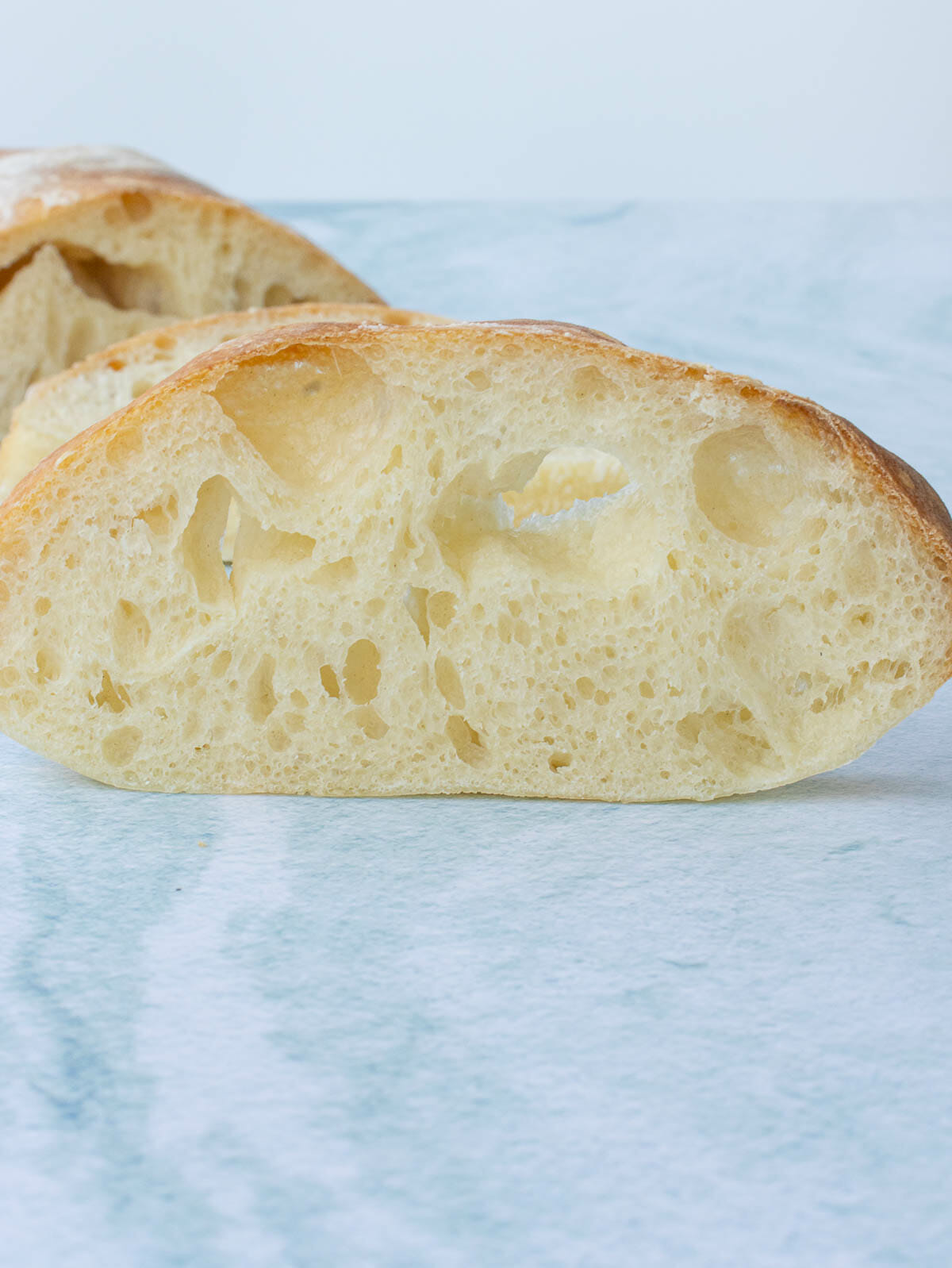

Leave a Reply